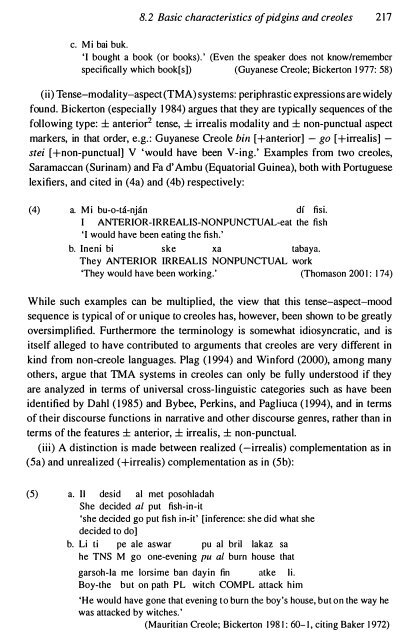Gram - SEAS
Gram - SEAS
Gram - SEAS
Create successful ePaper yourself
Turn your PDF publications into a flip-book with our unique Google optimized e-Paper software.
8. 2 Basic characteristics a/ pidgins and creoles 217<br />
c. Mi bai buk.<br />
'I bought a book (or books).' (Even the speaker does not know/remember<br />
specifically which book[s)) (Guyanese Creole; Bickerton 1977: 58)<br />
(ii) Tense-modality-aspect (TMA) systems: periphrastic expressions are widely<br />
found. Bickerton (especially 1984) argues that they are typically sequences of the<br />
following type: ± anterior 2 tense, ± irrealis modality and ± non-punctual aspect<br />
markers, in that order, e.g.: Guyanese Creole bin [+anterior] - go [+irrealis] -<br />
stei [+non-punctual] V 'would have been V-ing.' Examples from two creoles,<br />
Saramaccan (Surinam) and Fa d' Ambu (Equatorial Guinea), both with Portuguese<br />
lexifiers, and cited in (4a) and (4b) respectively:<br />
(4) a. Mi bu-o-ta-njan df fisi.<br />
I ANTERIOR-iRREALIS-NONPUNCTUAL-eat the fish<br />
'I would have been eating the fish.'<br />
b. Ineni bi ske xa tabaya.<br />
They ANTERIOR IRREALIS NONPUNCTUAL work<br />
'They would have been working.' (Thomason 2001: 174)<br />
While such examples can be multiplied, the view that this tense-aspect-mood<br />
sequence is typical of or unique to creoles has, however, been shown to be greatly<br />
oversimplified. Furthermore the terminology is somewhat idiosyncratic, and is<br />
itself alleged to have contributed to arguments that creoles are very different in<br />
kind from non-creole languages. Plag (1994) and Winford (2000), among many<br />
others, argue that TMA systems in creoles can only be fu lly understood if they<br />
are analyzed in terms of universal cross-linguistic categories such as have been<br />
identified by Dahl (1985) and Bybee, Perkins, and Pagliuca (1994), and in terms<br />
of their discourse functions in narrative and other discourse genres, rather than in<br />
terms of the features ± anterior, ± irrealis, ± non-punctual.<br />
(iii) A distinction is made between realized (-irrealis) complementation as in<br />
(Sa) and unrealized (+irrealis) complementation as in (5b):<br />
(5) a. II desid al met posohladah<br />
She decided at put fish-in-it<br />
'she decided go put fish in-it' [inference: she did what she<br />
decided to do]<br />
b. Li ti pe ale aswar pu al bril lakaz sa<br />
he TNS M go one-evening pu at burn house that<br />
garsoh-Ia me lorsime ban dayin fin atke Ii.<br />
Boy-the but on path PL witch COMPL attack him<br />
'He would have gone that evening to burn the boy's house, but on the way he<br />
was attacked by witches.'<br />
(Mauritian Creole; Bickerton 1981: 60-1, citing Baker 1972)
















